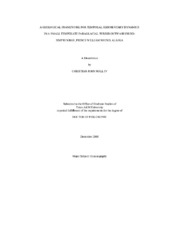| dc.description.abstract | Geophysical, geochemical and geotechnical methods were used to investigate the spatial and
temporal aspects of sediment distribution, accumulation, post-depositional alterations, and seafloor
response and recovery to major events in a temperate, paraglacial, turbid outwash fjord. The goals of this
study are to generate a complete geological model and compare the results to the global distribution of
fjords. The over arching theme of this study is that the ratio of the area of the watershed to the area of the
receiving basin can provide a first order indicator of many factors including glacial mass; the timing of
glacial retreat; sediment input, accumulation, and preservation; and other factors. Temporal observations
reveal the change of this fjord from a glaciated basin to and estuarine environment. These observations
become important when viewed in the context of global climate change and the continued loss of ice.
Preserved strata provide a 2800 yr record of changing modes of sedimentation as the system evolved from
a glaciated basin to a non-glaciated fjord revealing a detailed chronology of change between end-member
systems which can be used to infer changes as glaciers retreat from other fjords. Short lived radio isotopes
were used to investigate post-depositional alteration of modern sediments. Without an understanding of
how biological and physical processes work to modify sedimentary fabric during preservation, changes
seen in sediment and rock core data cannot be accurately resolved. Physical processes can cause erosion
and lateral transport; winnowing and armoring; and instantaneous sedimentation, all of which may be
preserved. Biological processes can modulate the preservation of strata by destroying sedimentary fabric
and integrating signals. The final fundamental need is to investigate the seafloor response and recovery to these events. Massive earthquakes are frequent in the study area and cause perturbations to sediment input
and preservation. By understanding how lakes and deltas modulate sediment discharge after the event;
how shorelines are modified after the event; and where sediment is deposited we can determine the
influence these changes have on the environment and on humans. | en |


